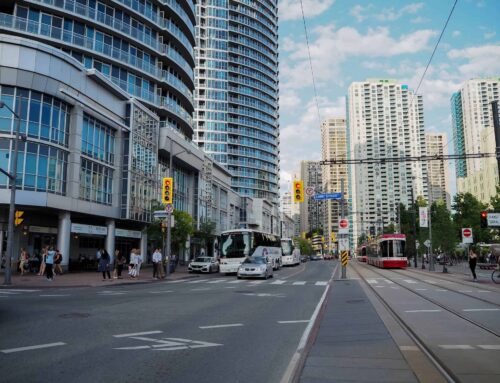Zoning describes the use of municipal authority to decided what land can be used for, and it defines allowable uses for residential, commercial, and industrial areas. Zoning is a powerful tool for every jurisdiction; it plays a role in how cities, regions, and neighborhoods develop. When done properly, zoning encourages economic growth and provides affordable housing for people who would otherwise be displaced or not have access to a community.
Related: Can Zoning Laws Reduce Pollution?
Creating Affordable Housing Through Zoning
There are two primary ways that zoning can help make housing more affordable: by increasing density with compact development and by creating and protecting affordability with zoning codes.
Density and Mixed-Use
The first component to increase housing affordability through zoning incorporates compact development, and it includes the concepts of mixed-use and high-density. Compact development doesn’t describe a specific project or building; it refers to a developmental approach in which multi-family or single-family homes get built at higher densities to maximize their land use.
Compact development uses zoning districts and overlays to develop larger homes with reduced property line setbacks, lower parking requirements, and more commercial space.
High-density zoning allows more units to get built in an area like apartment complexes and multi-family townhomes. Mixed-use zoning lets commercial buildings get included alongside residential ones.
Compact development contributes to housing affordability in multiple ways. Mixed-use neighborhoods allow for various land uses and facilitates a broader range of transportation activities, like public transit, reducing transportation costs and lowering the overall cost of living. High-density developments increase the number of houses available in a neighborhood, reducing high costs caused by supply issues. When larger amounts of homes are produced, the overall price per unit decreases.
Inclusionary Zoning
The second way that zoning can improve housing affordability is through inclusionary zoning. When developers pursue high-density buildings, the cost savings do not always get transferred to the consumers, especially when the housing supply is tight. That’s where inclusionary zoning can be an effective tool.
Inclusionary zoning programs tie the affordable housing development to the market-rate housing development by incentivizing or requiring specific percentages of units in new developments to be affordable for households with certain income ranges. Including these requirements guarantee that the benefits of the new developments are accessible to people with differing incomes.
Inclusionary zoning policies can get implemented with other transit-oriented projects to build a higher density of homes and non-residential spaced around new and existing transit stops. It also helps prevent displacement caused by increasing property values prompted by new developments and lets the whole neighborhood enjoy the benefit of a diverse range of households.
Related: Different Types of Zoning
Rezoning for Affordable Housing
Rezoning is changing the allowed density or approved land use for neighborhoods, and it occurs when the current land uses don’t match the jurisdiction’s developmental needs. Rezoning non-residential areas to residential ones get balanced between the potential impacts it will have on existing businesses and future job creation and economic development potential. A balanced approach lets areas benefit from fewer limits on residential development without affecting the area’s economic growth.
While politics can complicate rezoning, the process offers opportunities to create more affordable housing and a time for increased opportunity for public opposition. The process for rezoning is lengthy and requires multiple public hearings, and during this time, the new land use prepositions are vulnerable to speculation.
The Impact of Rezoning
Zoning’s technical details play an important role in the rezoning process. When land gets defined as residential, industrial, or commercial, zoning regulations in larger cities become more complicated. For example, they may have many different zoning districts in the city, and each one can set different regulations regarding land use, density, etc., which is why zoning tends to have very specific terms.
Rezoning Example: Parking Requirements
Other than the obvious impacts from zoning, like which types of businesses or services are allowed in the area, the more technical aspects have a massive effect on the form of development. Many zoning codes establish parking requirements, like one parking space per bedroom in a new apartment complex. These requirements can impose a burden on housing development, and by making changes to them, zoning can help increase the affordability of housing.
Parking Requirements for Specific Locations and Uses
One way that communities can create a more balanced parking policy is by reducing the required spaces in areas nearby robust public transport services. Also, some multi-family properties with lower car ownership rates could get parking space requirements cut back. Some neighborhoods may not be able to limit parking spaces, but others could benefit from more housing affordability by doing so.
Transit Joint Development
Joint development projects allow local transit agencies to partner up with private entities and develop new transit stations for commercial, residential, and other uses. These projects typically replace old parking lots with new, affordable public transportation.
Removing Parking Costs from Housing
Separating parking costs and housing costs can save residents money, reduce required parking spaces, and indirectly promote using public transit. There are a few ways to separate these costs:
- Reduce the number of parking spaces per unit to one with an option to rent or buy additional parking spots as needed.
- Sell or rent parking spaces to buyers or tenants under a separate contract with additional costs.
- Reduce rent for tenants who opt out of using parking spaces.
- In condo developments, let the owners rent parking spaces from their condo association and use that revenue to replace or supplement condo association fees.
Separating parking costs and housing costs lead to reduced housing prices and residents who can use other forms of transportation and opt-out of needing additional parking spaces.
Maximum Parking Requirements
Instead of establishing minimum parking space requirements, some communities are adopting maximum parking limits, placing a ceiling on how many parking spots can get provided in their neighborhoods that have access to public transit. These maximums encourage residents to use public transportation and help keep housing prices more affordable.
Do you need help with your land zoning issues? From compliance reports to PAC reports, Millman National Land Services has you covered!
Related: Zoning Variance and Change









